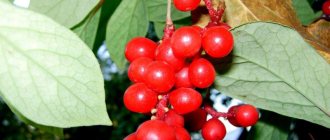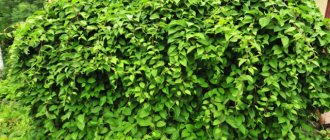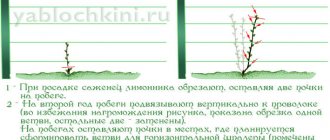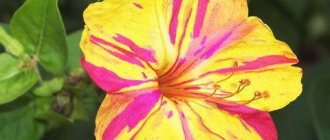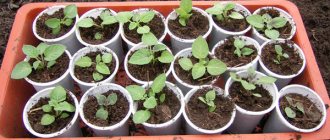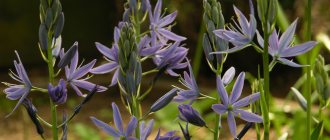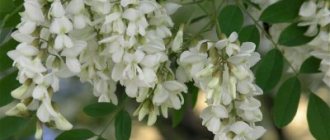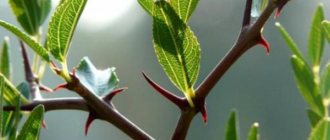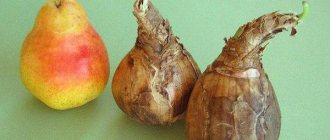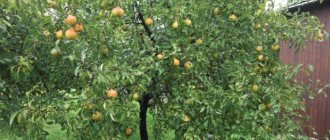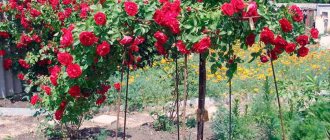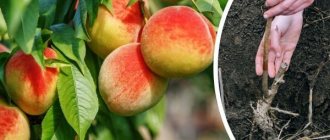05/14/2020 280 Tree-like
Author: Anatoly
Schisandra is a vine that can become a hedge or a full-fledged gazebo in the garden. The berries of this plant have a number of beneficial properties. It is possible to grow and care for Schisandra chinensis in any region of Russia.
[Hide]
Origin and botanical characteristics of lemongrass
Schisandra is a species of flowering plant from the Schisandaceae family and has nothing in common with lemon. The vegetation got its name in Russia because of the smell of the stems and the sour taste of the fruits.
Schisandra began to grow in China, where it acquired its local name “berry of five flavors.” It also grows in Japan and Korea. Not popular in Russia, but found in nature.
Geography of distribution in the Russian Federation:
- Sakhalin;
- Far East;
- along the coast of the Amur River;
- Khabarovsk region;
- Kuril Islands.
Schisandra chooses river valleys and forest edges as its habitat. Schisandra blooms in May; the process lasts only two weeks, but the berries can only be collected in September.
Appearance of Schisandra chinensis
The plant is a vine up to 15 meters long. At the dacha, gardeners plant it along fences or arches - lemongrass weaves around the base, creating a hedge.
Schisandra leaves are up to 3 cm wide and up to 10 cm long, they are sharp and slightly toothed. The stems of the plant are thin - up to 2 cm in diameter.
Medicinal properties of lemongrass
The composition of lemongrass berries is rich in useful substances:
- Sahara;
- ascorbic acid;
- Apple acid;
- lemon acid;
- wine acid;
- thiamine;
- riboflavin;
- topherol;
- fatty oil;
- essential oil.
The berries of this plant are used in medicine; medicines are prepared from them:
- hypnotic;
- sedatives;
- neuroleptics;
- psychostimulants;
- analeptics.
Schisandra is most often used as a raw material in the production of tinctures, as well as tablets and powders. In addition, they sell whole seeds and dry berries for making decoctions.
Dry lemongrass berries retain up to 50% of nutrients.
All parts of the plant are involved in the manufacture of medicines:
- leaves;
- bark;
- stems;
- roots.
In medicine, the fruits of lemongrass are divided into components - the juice is squeezed out of the berries and the seeds are taken. Oil is obtained from the roots and leaves, and the bark is used to prepare tinctures.
Schisandra is used in the treatment of the following diseases:
- respiratory diseases (whooping cough, bronchitis);
- baldness;
- lichen;
- ARVI;
- gastrointestinal diseases;
- avitaminosis;
- decreased sexual activity;
- non-healing wounds;
- fungal diseases;
- migraine;
- depression.
Lemongrass should not be used:
- children under 12 years old;
- for cardiac dysfunction;
- people with high blood pressure;
- during pregnancy and lactation;
- those suffering from epilepsy.
How to propagate by shoots
This is the most commonly used and less time consuming method. If young shoots appear near an adult plant, they can be separated.
To do this you need:
- Dig up young shoots with roots using a shovel, trying to damage the mother plant as little as possible.
- Transplant into prepared holes.
- Water the soil and mulch with rotted manure 2–3 cm thick.
Did you know? In modern medicine, preparations containing Chinese Schisandra are used in the treatment of asthenic syndrome, vegetative-vascular dystonia, recovery from illnesses, decreased performance as a result of physical or mental stress, and sexual dysfunction.
Choosing planting material
Breeding lemongrass is possible in two ways - young seedlings and seeds of ripe berries.
Schisandra seedlings
To plant lemongrass, choose bushes two or three years old.
The plant must be:
- healthy;
- with a developed root system;
- without damage;
- with smooth bark;
- with straight, uniform leaves.
Schisandra seeds
Seed material is collected in the fall. The grains are mixed with wet sand and stored in a cool place from 4 to 7 degrees so that they retain their properties until spring. If the seeds are kept indoors or in a container, it is important to ventilate them every two weeks. It is necessary to ensure that the sand does not dry out; if necessary, it should be moistened.
Reproduction by layering
Reproduction by layering should be carried out in the spring.
To do this you need:
- Dig a furrow up to 20 cm deep near the bush.
- Place a plant branch in the furrow in the form of a sinusoid.
- Secure at the lowest points with metal clamps or pegs.
- Cover the furrow with soil, leaving the top curves above the surface.
- Water the cuttings regularly until autumn.
- Next spring, separate with pruning shears and replant in a permanent location.
Planting a plant
Lianas act as decoration on the site; their place must be carefully selected. It is necessary to provide Schisandra with space for development and sufficient height of support.
Site selection and soil requirements
The ideal place for lemongrass is the south side of a fence or gazebo. It is better not to let vines along the walls of the house; they can get into the gutters and damage the roof.
In nature, the plant grows in forests on sandy and loamy soils. Despite their wild habitat, vines grow only in fertile soil with drainage elements. Schisandra needs light and loose soil, with the addition of organic and mineral fertilizers.
Soil mixture composition:
- Earth;
- sand;
- humus;
- ash;
- compost.
In the soil for growing lemongrass, there should be drainage from small stones or slate at a depth of 30–40 centimeters.
How and when to plant?
Schisandra is planted when the air temperature rises above 10–15 degrees - in April or May. In regions with hot climates, autumn planting is preferable - in October.
Holes for plants are dug at a distance of one meter from each other. A bed for lemongrass is prepared to a depth of 40 cm and a width of 60 cm. Special soil is poured into this hole, and then the sprout is planted. A fence of vines will turn out more beautiful if many seedlings are planted in a row.
Growing Chinese Schisandra from seeds
Growing lemongrass from seeds is more difficult than from seedlings. Seed material should begin to be prepared 2 months before planting. To do this, it is taken out of a cool room into a warm one (20 degrees) for 30 days, then brought back into a cool room (from 4 to 8 degrees) for a month.
Schisandra seeds can be sown in any garden bed; the seeds are only demanding on soil and lighting.
Seed growing process:
- In the selected bed, grooves are made at a distance of 50 cm from each other, 2 cm deep.
- The seeds are placed in the furrows, maintaining a distance of 20–30 cm, and covered with soil.
- After this, the beds are watered with a small amount of water, just slightly moistening the soil.
- Before the first shoots appear, the rows are covered with film to create a greenhouse effect.
- Then the sprouts are covered with material with ventilation or a mini-greenhouse is placed over the plant. Gardeners recommend growing lemongrass under a greenhouse for one year.
It is important to monitor soil moisture - you need to water 100 ml of water per seedling. If there is strong dampness, the young plant will die. Young seedlings are capricious to temperature changes and can wither from drafts and prolonged rain.
For wintering, the plant is covered with sawdust. Schisandra can be replanted to a permanent place in the spring - in April or May.
Propagation by seeds
The time to collect seeds is late October-early November. The multiberry takes on a slightly wrinkled appearance. This indicates the maturity of the seeds. Within three months after collecting the seeds, it is necessary to sow. Further, germination rate drops significantly.
Seeds can be bought at the store. When purchasing, keep an eye on the expiration date. After purchasing, you must immediately begin sowing. Don't keep them until May. If you have a multi-berry, then before sowing you need to crush it with your hands and remove the seeds.
Seed propagation can be carried out indoors and naturally. Indoor propagation is more difficult because it requires properly carried out stratification.
When propagating from seeds using the natural method, you must:
- Take a medium-sized pot for sowing, fill it with a mixture of sand and soil in a 1:1 ratio.
- Spread the seeds over the surface of the mixture, approximately 7-8 pieces. Use your finger to bury the seeds 1–2 cm.
- Bury the pot in a garden bed in partial shade and water it.
Sowing in a pot is very convenient, since lemongrass shoots may appear not in spring, but in summer. In addition, they look like herbaceous plants, so they are easily confused with weeds and trampled. In addition, the seeds will undergo stratification in a natural way. In the 2nd–3rd year after sowing, the plant can be planted in a permanent place. It will begin to bear fruit in 4–5 years.
Stratification
A month after collecting seeds, it is necessary to carry out stratification. Its duration is 1.5–2 months.
It must be carried out in stages:
- Prepare seeds for sowing: remove from berries, wash, dry.
- Soak them in water for 3-4 days in early December.
- Wrap in a fabric bag and place in a container with sand.
- For a month, keep the seeds in the sand at a temperature of +20°C, ventilate (for a few minutes) and rinse once a week (together with the bag, then squeeze).
- Mix the seeds with wet sand and place in the refrigerator at 0...+5°C for 1 month.
- Keep the container with seeds in the refrigerator in the fruit compartment at a temperature of +10°C for another 1 month.
Video: Stratification of lemongrass seeds
The seeds should crack before planting. It is better to sow in boxes. They are filled with a mixture of soil, sand and peat in a ratio of 1:1:2. Sowing is carried out in furrows up to 4 cm deep at a distance of 1 cm from each other, covered with earth, and the surface is covered with film. Shoots should appear in 14 days. It is necessary to regularly monitor soil moisture. When all shoots appear, the film is removed and kept on the windowsill in partial shade. At the beginning of summer, when 4 leaves appear, the plant can be transplanted into a greenhouse or open ground.
Growing seedlings
The process of planting a seedling:
- The soil mixture is poured into a prepared hole with drainage at the bottom.
- Make holes at a distance of one meter from each other.
- Mineral fertilizers are added to each hole - 20 grams of superphosphate and a liter of mullein diluted with water in a ratio of 1/1.
- A lemongrass seedling is placed in the hole and buried so that the roots are not visible.
- Then water the plant in the amount of 5 liters per bush.
Planting seedlings of Schisandra chinensis is presented in a video from the “Our Hobby” channel.
Cuttings
Propagation by cuttings must be carried out in mid-June before or during flowering. To do this, shoots that are green-brown in color and not lignified are cut off. The cuttings should be 4–8 cm long and have 3–4 buds. The upper cut is straight, the lower cut is oblique. The distance from the cut to the nearest bud is about 5 mm. Treating cuttings with a growth stimulator will help rooting. As a stimulant, you can use Heteroauxin. It is diluted with water in a ratio of 1:10.
Cuttings of Schisandra chinensis are carried out in stages:
- Prepare the greenhouse for planting.
- Cut cuttings of the required length from green shoots.
- They are treated with a growth stimulator throughout the day.
- They plant and water.
- Cover the planting with film or glass.
Did you know? Schisandra juice is used to create an unusual aroma in wine.
For rooting, cuttings are planted in a greenhouse . The soil for the greenhouse is light, fertile, covered with a layer of sand 3–4 cm thick. Planting is carried out in rows at a distance of 5 cm from each other in an inclined form. Planting depth is 2–3 cm to the second bud from the bottom. The planting is watered and the greenhouse is covered with film or glass.
Ventilation and spraying of cuttings with water must be carried out regularly throughout the summer . It is also necessary to ensure that the soil does not dry out. For the winter, it is better to hide the cuttings from freezing in the basement. To do this, you need to dig them up along with a lump of earth and plant them in a box. It should be planted in a permanent place in the spring. If 50% of the cuttings have taken root, this is a good result.
Caring for lemongrass at home
At home, lemongrass grows without causing problems for the gardener. In spring and autumn, the plant requires preventive sanitary work. In summer, you need to care for the vines by regularly watering and feeding them.
Watering and fertilizing
One plant needs to be watered with 50–60 liters of water 2–3 times a week. After moistening the soil, mulch it, since the roots are located close to the surface of the earth and can dry out. In hot weather, lemongrass should not be sprayed or watered during the day - it will get burned; these procedures are carried out in the evening.
The first three years of life, lemongrass is not fertilized. If the plant develops poorly and has external defects, you can feed it with organic means - compost, humus.
Regularity of fertilizing (per 1 square meter):
- April - until the buds appear. Potassium - 40 grams, phosphorus - 40 grams, nitrogen - 40 grams, ammonium nitrate - 20 grams.
- May - when the ovaries appear. Potassium - 15 grams, superphosphate - 15 grams, nitrogen - 20 grams.
- September and October - after harvest. Nitrophoska - 50 grams, ash - 100 grams.
In summer, fertilizers for lemongrass should be diluted in 5 liters of warm water and the mixture should be poured under the root. In spring and autumn, you can add granules to the soil without diluting them.
The minerals that lemongrass needs from the third year of life are presented in the table.
| Name, price | Description |
| Nitrogen 45 rub. | Compound:
Mineral element:
|
| Superphosphate 62 rub. | Compound:
Actions of the complex:
|
| Potassium sulfate 78 rub. | Compound:
Effects of fertilizer:
|
| Nitrophoska 94 rub. | Includes:
Environmentally friendly, complex fertilizer:
|
| Ammonium nitrate 51 rub. | Composition: nitrogen and sulfur. Sulfur helps the plant absorb nitrogen. Fertilizer speeds up the metabolic process. |
Trimming
Schisandra pruning should be done in summer and autumn.
In summer, a crown is formed, excess branches and shoots are removed. For healthy plant growth, leave 5 shoots per 10 buds. In autumn, weak and dry branches are cut off and disease prevention is carried out.
New root shoots are also removed. It is necessary to remove those that are located far from the mother stem; they are cut below ground level.
Support
A trellis is often used as a support; it is strengthened in the ground next to the seedling. First you need to wrap the vines around the base, then they will grow along it themselves.
Trellis - arch
Trellis in an open area
Trellis near the walls of the house
Preparing the plant for wintering
Saplings over 4 years old are not covered for the winter. Young shoots need insulation from dry leaves or wintering under a greenhouse shelter.
Summary table of monthly lemongrass care
Every month, lemongrass requires certain care actions.
| Month | Actions |
| March |
|
| April |
|
| May |
|
| June |
|
| July |
|
| August | Repeat of July actions. |
| September |
|
| October |
|
Plant diseases and pests
Pests do not settle on this plant - they are repelled by the sour smell of lemon.
Fungal diseases of lemongrass:
- Phyllosticosis. Symptoms are dark spots with a purple circle on the leaves. The plaques grow and holes appear in their place. You need to treat with drugs containing copper - Ordan, Hom.
- Powdery mildew. White coating on the leaves, which can occur on both sides. Appears during sudden cold snaps and prolonged damp weather. In the early stages it is treated with a solution of soda ash. It is possible to use fungicides - Topaz, Fundazol.
- Ascochyta blight is a type of rot. Appears as small brown spots. Treated with Bordeaux mixture.
- Fusarium. The disease is found on the stem in its lower part and at the roots. It looks like a brown ring that softens the base of the stem. If neglected, the plant will die. It is best to remove a diseased seedling in the early stages, before it infects neighboring vines. After removing the diseased sprout, the soil is disinfected with a solution of potassium permanganate. To prevent this disease, seeds are treated with the fungicide Maxim.
- Ramulariasis. Brown spots appear on the leaves, which eventually become covered with a white coating. The disease reduces the yield by half. Treated with Bordeaux mixture and fungicides. Before spraying, diseased areas of the plant are removed and burned outside the garden area.
If one Schisandra bush becomes diseased, it is necessary to carry out preventive measures on all seedlings on the site in order to avoid mass infection.
Preparations for the treatment and prevention of Schisandra diseases.
| Name, price | Description |
| Home 42 rub. | Fights fungal diseases:
Ingredients: copper oxychloride. When interacting with metal, the drug causes corrosion. |
| Order 46 rub. | Disinfects the plant from fungal diseases. Contains copper oxychloride and cymoxanil. Unlike Khoma, Ordan has healing functions - it restores the structure of the plant. |
| Topaz 70 rub. | The drug is used to treat powdery mildew and rust. Ingredients: penconazole. The fungicide can be used in wet weather; it is not washed off by precipitation. |
| Fundazol 40 rub. | Destroys fungal diseases in plant seeds:
Forms a protective coating around the leaves. Can be used in any weather conditions. Also kills pests:
Contains benomyl. |
| Bordeaux liquid 100 rub. | Protects plants from all fungal diseases. When preparing it yourself, you must follow the proportions of 1 part lime to 1 part vitriol, otherwise the fungicide will burn the leaves. Compound:
|
| Maxim 23 rub. | The drug is of natural origin, the active substance is secreted by beneficial soil bacteria. It can be used both for treating seeds against fungal diseases and for treating adult plants. Ingredients: fludioxonil. |
Photo gallery
Photo of Chinese lemongrass.
Schisandra flowers
Chinese lemongrass fruits
Lianas on an arched structure
